Living in Osaka Vs. Tokyo
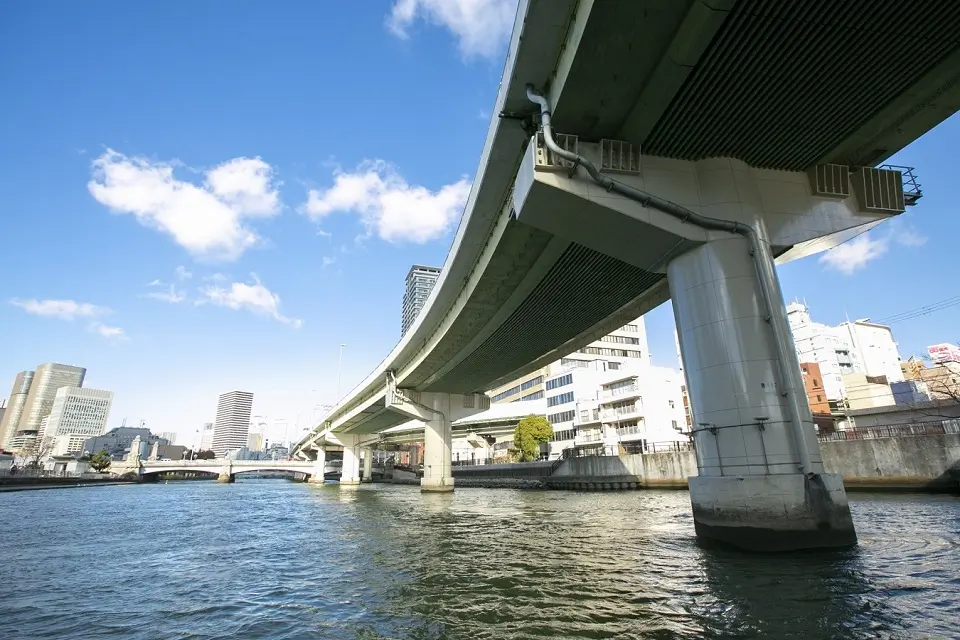
Osaka vs. Tokyo? This is a very common question debated not just by foreigners but also by Kansai and Kanto people. Here are some facts and statistics about these two of the biggest cities in Japan.
As a foreigner, living in Osaka is an entirely different experience than living in the capital city of Tokyo. In fact, the difference can be unimaginable for people who have not experienced life in either of these cities. While this article will discuss various facts about Osaka, the focus will be on living in Osaka. I will also compare Osaka and Tokyo, including the cost of living and other aspects of Osaka Vs. Tokyo.
Osaka’s history dates back to the 5th century when it was known as Naniwa-kyō (難波京), a significant political and economic hub. Over the centuries, Osaka has stood as a symbol of Japan’s resilience, surviving numerous wars and natural disasters.
Osaka is known among the locals as the “city of water” due to its abundant waterways. The city’s canals were used as transportation channels and were vital to the prefecture’s flourishing.
Many of Osaka’s famous sights are along canals like Dotonbori. However, Osaka is also well known for its food culture. Tiny back alleys are lined with Izakaya, bars, and cafes serving some of the best food around Japan.
Overview of Osaka City
Osaka is the largest city in the Osaka Prefecture Osaka-fu (大阪府), located in the Kansai region of the Honshu Island of Japan.
Osaka Metropolitan area is Japan’s second-most populous area and the 10th-most populous in the world, behind Tokyo and Yokohama. Among all the prefectures of Japan, Osaka prefecture ranks third, with a population of 8.809 million, according to the 2019 census. Osaka-Shi, the biggest city of Osaka, also ranks as the third-largest city in Japan, with an estimated population of 2,754,440 in 2021.
Osaka City is divided into 24 wards, as shown in the map below. Hirano-Ku ward is the most populous, with a population of 192,152, and Taishō-Ku is the least populous, with a population of 62,083 as of the 2020 census.
24 Wards of Osaka
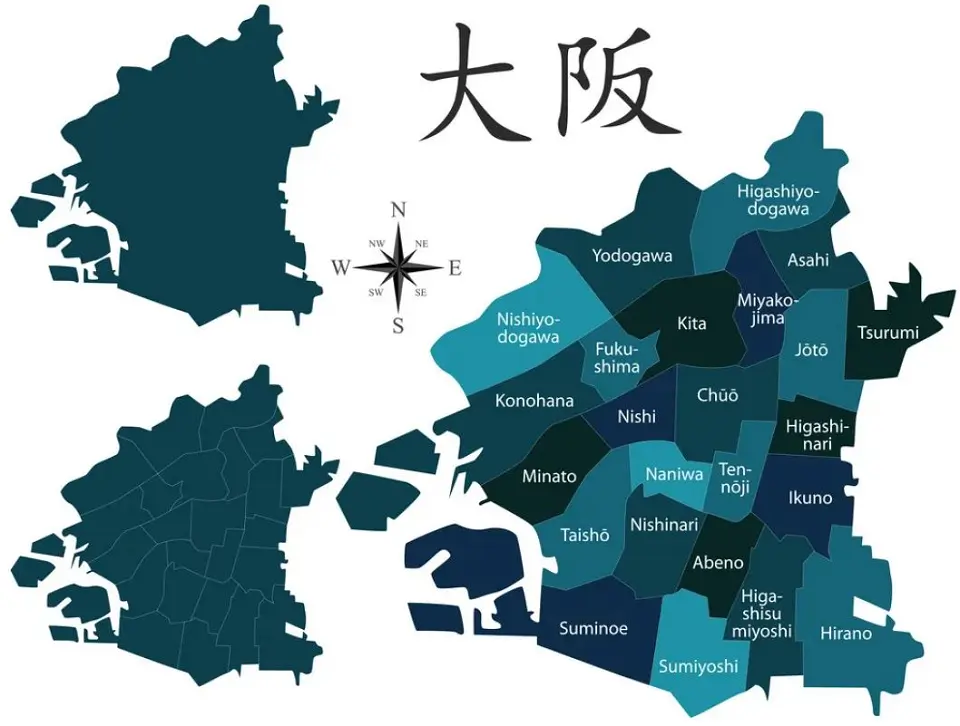
Tokyo Vs. Osaka
It’s very common for people to compare Osaka and Tokyo, and with good reason. They are two of Japan’s largest 3 metropolitan areas, but the significant differences between life in these two cities make it natural to spark the Tokyo Vs. Osaka discussions.
Though Yokohama is the second-largest city in Japan after Tokyo, it is in the Tokyo metropolitan area and has no dramatic contrast. So, in a way, we can find many similarities between Tokyo and Yokohama. However, it is quite different when it comes to Tokyo and Osaka.
Unlike Tokyo, in many different ways, living in Osaka can often feel like living in another country. With the reputation of being the 3rd largest city in Japan, Osaka may sound like a very large city; however, the numbers tell a different story.
While Tokyo prefecture’s population is over 13.99 million, Osaka prefecture, with close to 8.83 million people, though slightly less than Kanagawa prefecture’s 9.126 million, is far behind Tokyo.
However, a more important point is that the population of Tokyo City’s 23 wards is 9,733,276 (2020 census), against the mere slightly over 2.7 million people in Osaka City. So, it’s unsurprising that Tokyo has a fast-paced, cosmopolitan atmosphere with diverse districts and neighborhoods. Conversely, Osaka is famous for its lively, friendly atmosphere and distinct local culture.
Osaka Dialect
A much-talked-of distinction of Osaka is its dialect. Some people call it Osaka ben, and some as Kansai ban. However, both of these representations of the Osaka dialect are incorrect. Kansai ben is actually not one dialect but a group of dialects spoken in the Kansai region. Osaka, the biggest and most prominent area of the Kansai region, is often associated with all the variations of dialects of the entire Kansai region.
Osaka shares a common dialect with Kyoto, and it is known as the Kamigata (上方言葉) dialect.
The more intimate and casual-sounding Kamigata dialect differs from the standard Japanese. It reflects the more friendly, casual, and laid-back nature of the people of Osaka than Tokyo.
Right-Hand Vs. Left-Hand Side
Another interesting difference between Tokyo and Osaka, or the entire Kanto and Kansai region, is the different sides of escalators where people stand to give way to people in a hurry and who wish to climb up or down the staircase.
In the Tokyo and Kanto regions, people stand on the left side of the escalators, while in Kansai, including Osaka, people stand on the right side. Imagine the mess it makes on the Shinkansen stations of Tokyo and Osaka, for Shinkansen between these two cities, with people standing on both sides of the escalators, leaving no space for a person to climb up or down in a hurry!
Cost of Living: Tokyo Vs. Osaka
The cost of living in Tokyo is higher than in Osaka, especially regarding housing, food, and entertainment.
Housing
Housing is generally the biggest expense in both cities, but it can be more expensive in Tokyo. For example, in Tokyo, a one-bedroom apartment in the city center may cost around ¥120,000 to ¥180,000 per month, whereas, in Osaka, you could find a similar apartment for around ¥75,000 to ¥120,000 per month.
However, it’s worth noting that the cost of housing can vary significantly depending on the neighborhood and the apartment size. The cost of basic utilities, including electricity, gas, and water, is similar in both cities. You may like to check the guides about average rent in Tokyo. and the cost of living in Japan.
Groceries
The cost of groceries is relatively similar in both cities, but some items might be slightly more expensive in Tokyo. For instance, a liter of milk may cost around ¥200 in Tokyo, while it might be around ¥180 in Osaka.
Local Transportation Cost
The cost of a single ride on the subway or bus is fairly comparable between the two cities, with ¥200 to ¥300 per ticket. However, being a much larger city, Tokyo can result in much higher monthly transportation costs. For example, a monthly public transportation pass in Tokyo may cost around ¥10,000 to ¥15,000, while in Osaka, it’s about ¥7,000 to ¥10,000
Leisure and Entertainment
Regarding entertainment and leisure activities, Tokyo and Osaka offer various options at various price points. However, Tokyo tends to have more high-end and luxury options, while Osaka has a reputation for being a more laid-back and casual city.
Eating out in both cities can vary, but dining in Tokyo is more expensive than in Osaka. For example, a meal at a mid-range restaurant for two in Tokyo might cost around ¥5,000 to ¥8,000, while in Osaka, the same meal may cost around ¥4,000 to ¥6,000.
Cost Comparison as per Contributed Data
As per Numbeo, the cost-of-living comparison of Tokyo and Osaka is as follows:
- Consumer Prices in Osaka are 13.7% lower than in Tokyo (without rent)
- Consumer Prices, Including Rent in Osaka, are 21.0% lower than in Tokyo
- Rent Prices in Osaka are 38.4% lower than in Tokyo
- Restaurant Prices in Osaka are 3.3% lower than in Tokyo
- Groceries Prices in Osaka are 21.2% lower than in Tokyo
- Local Purchasing Power in Osaka is 5.6% higher than in Tokyo
Foreigners in Osaka
Osaka ranks quite high in the total number of foreign residents in Japan.
According to June 2022 Japanese government data, 566,525 foreigners live in Tokyo prefecture, which ranks number 1 in Japan. Tokyo is home to 19.13% of the 2,961,969 foreign residents and 4.05% of the total population.
However, Osaka ranks second with 262,681 foreign residents, which is 8,87% of the total foreign residents in Japan and 2.97% of the total population of Osaka.
In fact, Osaka has more foreigners than Japan’s second-most populous prefecture, Kanagawa-Ken, which has 237,450 foreign residents.
Educational Facilities in Osaka
Osaka has several notable educational facilities. Some of the highlights of educational facilities in Osaka include:
- Osaka University: This is a top-ranking national university in Japan, known for its research programs in science and technology, medicine, and social sciences.
- Osaka City University: This is another top-ranking national university in Japan, focusing on social sciences, humanities, and life sciences.
- Osaka Prefecture University: This is a public university that offers undergraduate and graduate programs in a range of fields, including engineering, life sciences, and social sciences.
- Osaka International University: This is a private university that offers undergraduate and graduate programs in a range of fields, including business, education, and engineering.
- Kansai University: This private university offers undergraduate and graduate programs in law, economics, and business.
- Osaka Gakuin University: This is a private university that offers undergraduate and graduate programs in a range of fields, including theology, law, and economics.
- Osaka City College of Technology: This is a public college that offers vocational training programs in a range of fields, including engineering, information technology, and business.
- Osaka University of Tourism: This private university offers undergraduate and graduate programs in tourism, hospitality, and related fields.
International Schools in Osaka
Several international schools in Osaka cater to the needs of expatriate families and international students. Some of the prominent international schools in Osaka are:
- Osaka International School: This private, co-educational school offers an international curriculum for kindergarten to grade 12 students. The school follows the International Baccalaureate (IB) program and offers courses in English and Japanese.
- Canadian Academy: This private, co-educational school offers an international curriculum for kindergarten to grade 12 students. The school follows the IB program and offers courses in English.
- St. George’s International School: This private, co-educational school offers an international curriculum for kindergarten to grade 12 students. The school follows the IB program and offers courses in English.
- Kansai Christian School: This private, co-educational school offers an American-style kindergarten to grade 12 curriculum. It is affiliated with the Association of Christian Schools International (ACSI) and offers English courses.
- Deutsche Schule Kobe / Osaka: This private, co-educational school offers a German curriculum for kindergarten to grade 12 students. The school follows the German education system and offers courses in German and English.
Where to Live in Osaka
Since the cost of living in Osaka is much cheaper than in Tokyo, it’s pretty easy to find cost-effective housing surrounding the city center. However, as in every city, the housing in the downtown area is comparatively more expensive.
The higher accommodation cost may force you to sacrifice the convenience of having a larger place to stay.
For those looking for a little more space, living a little distance from the center is an equally viable option. Some of such areas where you can find comparatively larger accommodation and more cost-effective prices are as follows:
Higashi Osaka
As the name suggests, it’s the eastern part of Osaka and includes the Osaka-Kobe metropolitan areas.
Higashi Osaka is known as a community of monozukuri (物作り), or craftsmanship in English, because it has the highest ratio of factories to land area in Japan. However, most of the factories are small and medium-sized businesses in Higashi-Osaka.
With a total population of 495,011 and an area of 61.78 square km, the population density of Higashi-Osaka is 8012.5 people per square kilometer, which is 67.62% of the population density of main Osaka city. So, you can undoubtedly enjoy larger accommodation at better prices in this area.
Main Attractions of Higashiosaka
It’s not just about the affordability of a nice accommodation, which is important about where you choose to live; it’s about the neighborhood. Following are some of the places in Higashi-Osaka that you will find good to be around:
- Hiraoka Shrine
- Omakeya ZUNZO
- Shiba Ryotaro Memorial Museum
- Konoike Shinden Kaisho Museum
- Hanazono Rugby Stadium
Yao
Only a stone’s throw away from Osaka city towards the southeast, Yao city features picturesque sights, abundant mountains, and ancient burial mounds. The city is the birthplace of Kawachi Ondo-style folk singing and has an annual festival, including folk song demonstrations and traditional Bon Odori dance.
With an estimated population of 263,436 in 2022, Yao has a population density of 6300 persons per square km, which is close to 50% of Osaka city.
Local Attractions of Yao
- Taiseishōgun-ji: A Buddhist temple founded in 587 A.D.
- Shionjiyama Kofun
- Takayasu Senzuka Kofun
- Yuge-dera
Toyonaka
Toyonaka is a residential area in northern Osaka. Many of its residents commute daily to the city to work. Some key points of interest in the town are Harada Shinto Shrine and Hattori Ryokuchi Park.
The population density of Toyonaka is 11,000 people per square km, which is close to the population density of Osaka City. The reason is the presence of Osaka International Airport, which is partially located in Toyonaka and partially in Itami City.
Hirakata
A city in northeastern Osaka, Hirakata is a residential area close to Osaka City and Kyoto.
As per December 2021 estimates, Hirataka’s population was 397,681, with a population density of 6100 persons per square km.
With 7 universities and colleges, Hirataka also has an amusement park among the following attractions:
Things to Do and Places to Visit in Osaka
Like Tokyo, the capital, there are plenty of areas to sightsee around Osaka and the entire prefecture.
Known as Japan’s “kitchen,” many visitors are eager to try Osaka’s unique foods and cuisine.
Osaka Delicacies
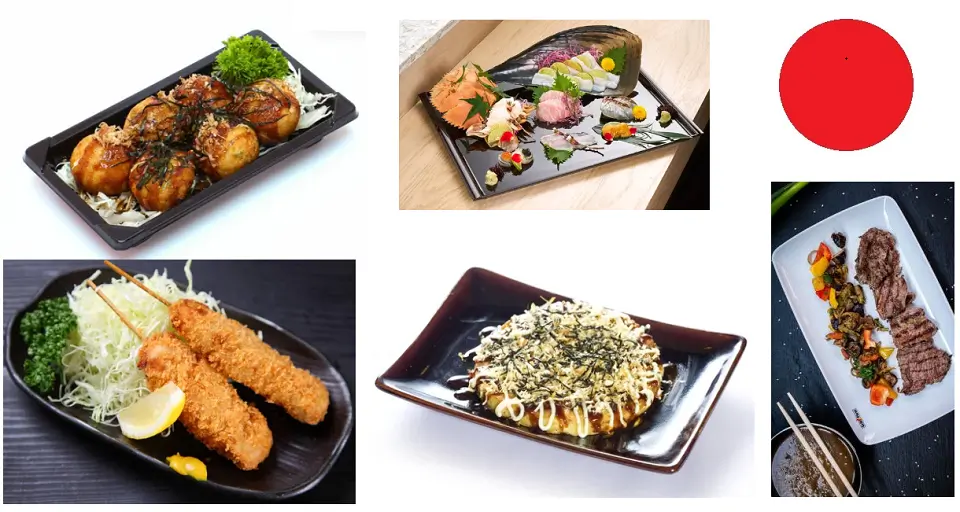
Japanese people love to eat. Many foreigners new to Japan are surprised to see so many programs about food, even on television. However, the Osaka people are especially known for their obsession with food.
The expression “Kuidaore” in Osaka, which means eat till you are bankrupt, expresses the Osaka people’s obsession with food.
Though you can enjoy a wide variety of food in Osaka, the following delicacies are especially famous in Osaka:
Takoyaki

The scrumptious golden-brown spheres of Takoyaki, with their crispy exterior and tender octopus filling, are a beloved street food in Japan and a symbol of culinary ingenuity.
The playful and addictive nature of Takoyaki, with its creamy center, savory toppings, and gooey sauce, makes it a perfect snack for any occasion and a testament to Japanese cuisine’s unique and flavorful offerings.
Okonomiyaki

With its savory aroma and sizzling sound emanating from the griddle, Okonomiyaki is not only a beloved Japanese comfort food but also a spectacle of culinary creativity as each layer of batter, cabbage, and toppings are artfully arranged and flipped with precision.
Okonomiyaki, a versatile dish that can be customized to suit individual preferences, is a fusion of textures and flavors that tantalizes the senses with its crisp exterior, soft interior, and umami-rich toppings, making it a beloved staple in Japanese cuisine. Kushikatsu:
Kushikatsu
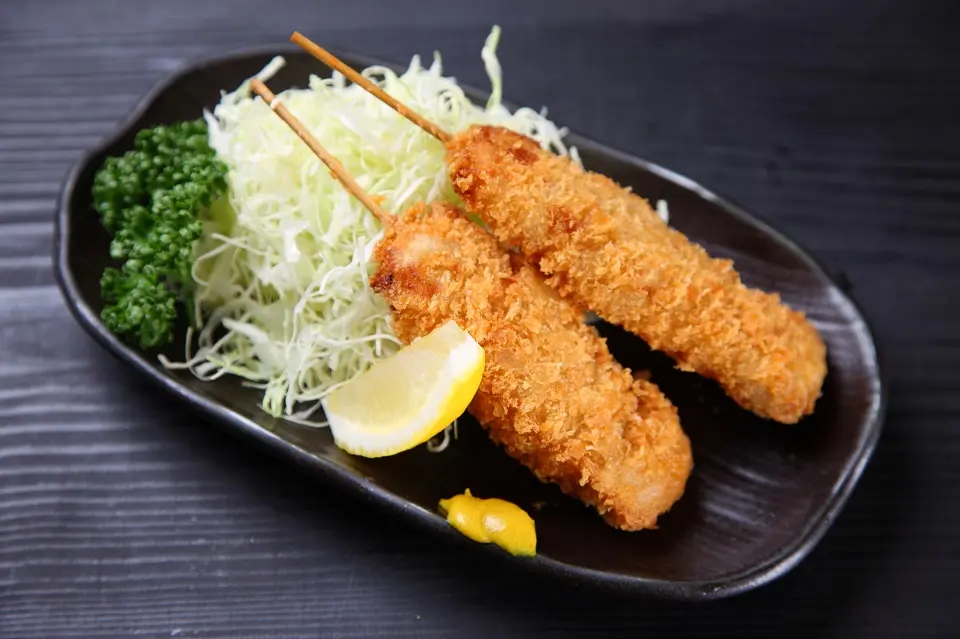
A quintessential Osaka Street food features an array of deep-fried skewered bites that tantalize the taste buds with their crispy golden exterior and juicy, succulent filling.
The artful arrangement of colorful Kushikatsu sticks on a plate, each crumb-coated and lightly fried to perfection, presents a feast for both the eyes and the palate, making it a beloved indulgence in Japanese cuisine.
Fugu
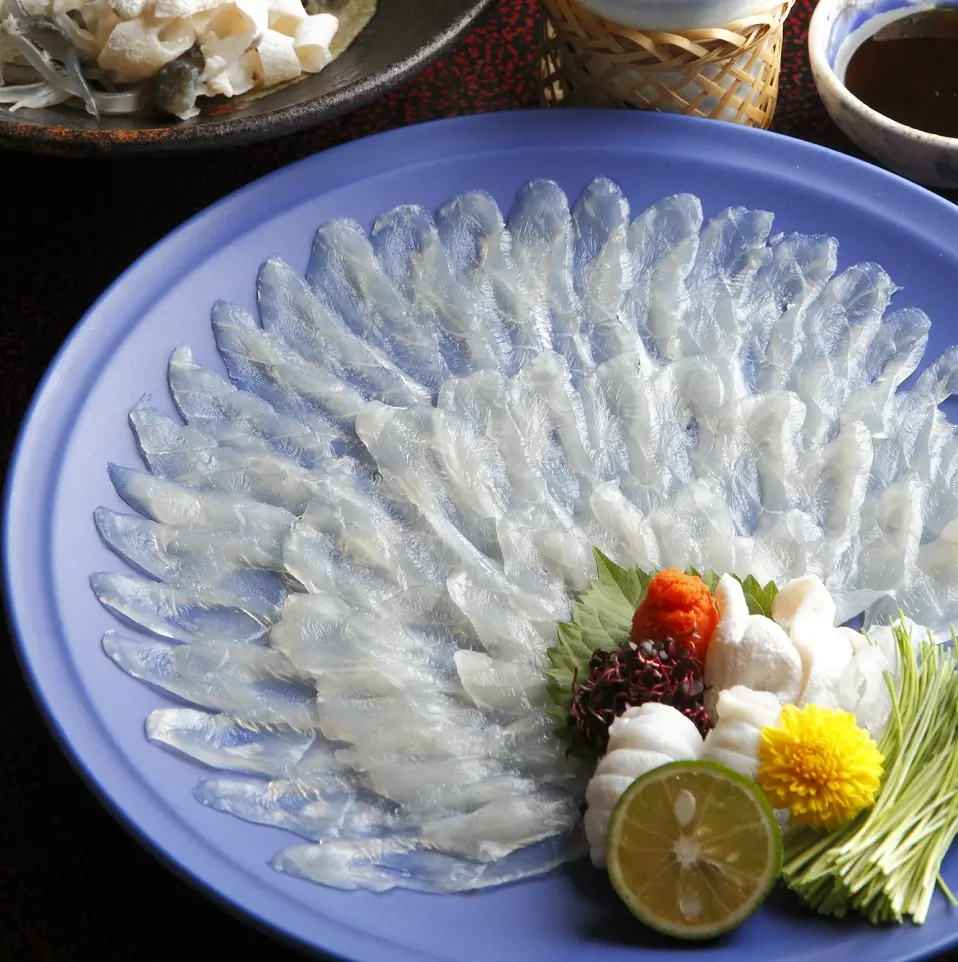
Fugu, the infamous Japanese delicacy, is not just a dish but a test of culinary skill and precision. Only expertly trained chefs can safely prepare the deadly pufferfish for consumption.
Fugu’s delicate and subtle flavor, with its tender and translucent flesh, is a testament to the Japanese culinary philosophy of simplicity and respect for the natural essence of the ingredients, making it a highly sought-after and exclusive dish.
Yakiniku
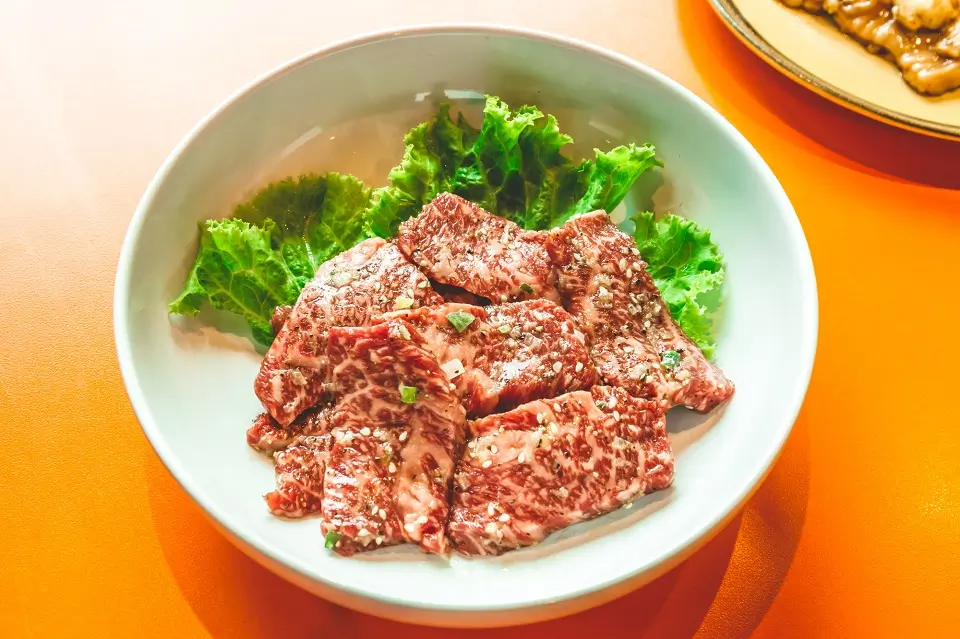
Yakiniku, the Japanese style of Korean barbecue, is a culinary experience that combines the sizzling sound of meat cooking on a grill with the smoky aroma and bold flavors of bell pepper, various vegetables, and marinades.
The art of Yakiniku emphasizes quality meat, expert grilling techniques, and the balance of sweet and savory flavors. Yakiniku represents the vibrant and dynamic fusion of Japanese and Korean culinary traditions.
The interesting question is, while Korean restaurants in Japan developed the Yakiniku style of barbeque, why is Osaka famous for it?
Well, if we dig deeper into it, the answer is quite simple. As per 2022 estimates, the Korean population of Osaka prefecture is 90,141, i.e., 34.3% of Osaka’s total number of foreign residents. The number of Koreans is higher in Osaka than in any other prefecture of Japan. Even Tokyo, with 58.4% more population than Osaka, has only 87,274 Koreans, i.e., less than Osaka.
Apart from restaurants, you may also like to know about the places for outdoor barbecues in Osaka,
Places to Enjoy in Osaka
Universal Studios Japan
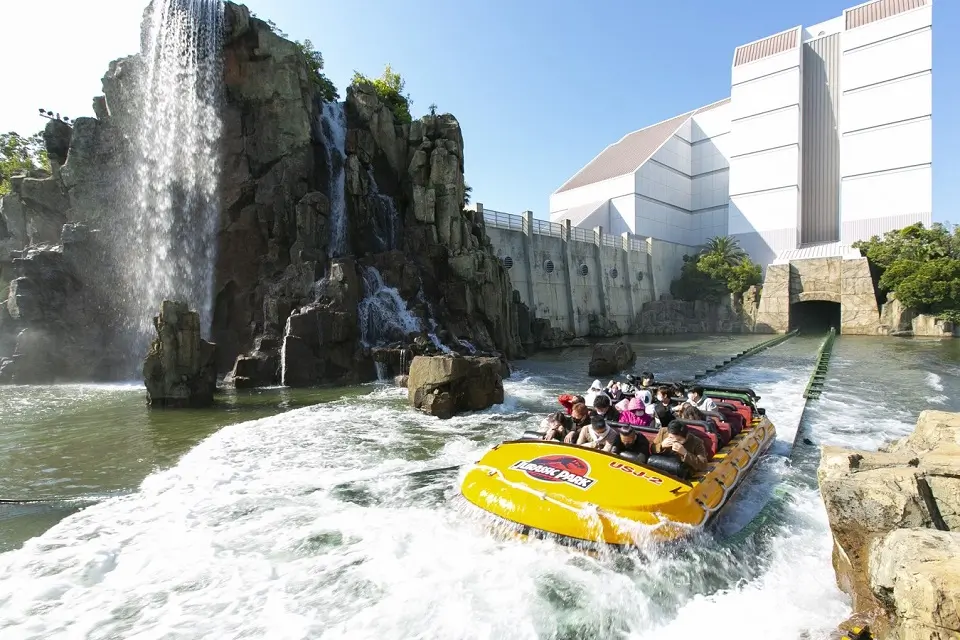
While Tokyo has Disneyland and DisneySea to refresh everyone, Osaka competes with Tokyo despite its age with its notable theme park, Universal Studios Japan (USJ).
Osaka’s Universal Studio currently has ten sections, including Harry Potter World, Super Nintendo, Minion Park, Jurassic Park, and Universal Wonderland.
In addition to the rides, visitors can enjoy photos with characters, a night parade, and the Universal City Walk just beyond the park gates.
Osaka Castle
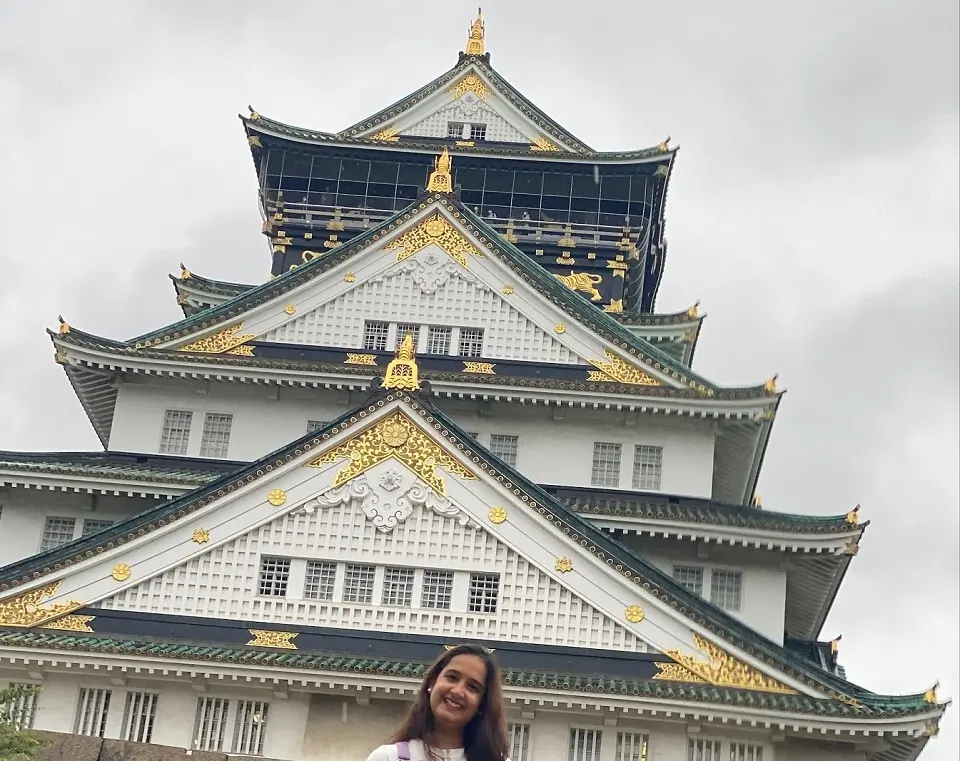
Previously, the Ishiyama Honganji Temple site, Osaka-jo (大阪城), is one of the most historic sites in the Kansai region.
Oda Nobunaga destroyed the temple in the 1500s to construct the castle in 1583. Osaka Castle has been restored numerous times due to war damage and natural calamities like lightning.
Under Toyotomi Hideyoshi’s rule, the castle was originally intended to be the sight of a unified Japan. However, after his death, Tokugawa troops destroyed the castle once again. After being targeted many times throughout history, the castle had the last major repair work in 1997 and now holds a museum about Toyotomi Hideyoshi and the castle’s history.
Dotonbori
Kuidaore (食い倒れ), which loosely translates to “eating until you’re broke,” is taken to the next level in the Minami area of Osaka. Dotonbori is a must-see in Osaka City. Found along the Dotomborigawa River, the area features dozens of restaurants and small bars squeezed into the area.
Along with the restaurants, visitors can see colorful neon lights to add to the club’s high-paced energy. Be sure to take a picture of the Glico Man while you’re there.
Namba
The second major city center is Namba, famous for its entertainment, shopping, and dining. It’s also easily accessible, as it’s served by three train lines, subway systems, and a highway bus terminal.
The Bay Area
An artificial waterfront island and peninsulas accommodate Osaka’s sprawling growth. The district hosts a variety of tourist attractions, including museums, theme parks, observatories, and shopping centers.
Osaka Vs. Tokyo: The Conclusion

The comparison of Tokyo and Osaka can be summarized in the following points:
- Size and Population: Tokyo, Japan’s capital and largest city, is significantly more populous than Osaka. Tokyo’s size contributes to the city’s bustling, fast-paced nature, while Osaka, though still a large city, often feels more manageable and laid-back.
- Career Opportunities: Tokyo, being the economic and political center of Japan, tends to offer more diverse career opportunities, particularly in fields like finance, technology, and fashion. On the other hand, even with a fairly large economy, the number of career opportunities in Osaka is considerably less than in Tokyo. Moreover, unlike Tokyo’s diverse career opportunities, which encompass every domain, Osaka’s economy is more focused on manufacturing and electronics.
- Cost of Living: The cost of living in Tokyo is higher than in Osaka. Osaka, while still not cheap, can offer a more affordable lifestyle, particularly for those on a tighter budget.
- Cuisine: Both cities have a rich culinary tradition, but the focus differs. Tokyo’s global food scene has various international cuisines and high-end dining options. Osaka, often called “the nation’s kitchen,” is famous for its street food and local delicacies like takoyaki and okonomiyaki.
- Cultural Differences: Tokyo is often seen as more formal and reserved, reflecting traditional Japanese manners and etiquette. Osaka is known for its friendly, outgoing locals and a more relaxed atmosphere.
- Nightlife: Tokyo’s nightlife is world-renowned, with many options ranging from clubs in Roppongi to bars in Golden Gai. Osaka also has a vibrant nightlife, focusing on local pubs (izakayas) and entertainment districts like Dotonbori.
- Nature and Outdoor Activities: While both cities offer parks and green spaces, Tokyo is closer to iconic natural attractions like Mount Fuji. Conversely, Osaka has easier access to the historic cities of Kyoto and Nara, offering a different outdoor experience.
Which is Better for you?
Osaka is a great place to live to experience Japanese traditions from an era when Japan did not attain the famous and sometimes infamous reputation of being the country of only discipline, processes, formalities, and standardization at the cost of humaneness. Not just Osaka but its surrounding areas give the experience of being in modern Japan with a more traditional touch than in Tokyo.
However, nothing is absolute, and the good and bad points of any place (or person) depend on what we seek.
If you have the option of Tokyo Vs. Osaka you must consider that while Osaka offers a blend of modern and traditional Japan, a relaxed lifestyle, and a lower cost of living, it falls short of Tokyo in providing career opportunities for foreigners who come to Japan primarily for professional reasons. Therefore, when deciding between Tokyo and Osaka, it is crucial to determine which city aligns better with your objectives.
If your primary objective is to pursue career growth, Tokyo’s staggering GDP of US$1,600 billion outshines Osaka’s US$181 billion GDP.
On the other hand, if you are seeking a balance between experiencing Japan and advancing your professional career, starting your journey in Osaka or the Kansai area and later moving to Tokyo can be an ideal choice. As a foreigner in Japan, I followed this path and found it a great way to explore the Land of the Rising Sun while growing my career.

A long-term ex-pat in Japan, Himanshu comes with an IT background in SAP consulting, IT Business Development, and then running the country operations of an IT consulting multinational. Himanshu is the co-founder and Managing Director of ReachExt K.K. and EJable.com. He is also an Advisory Board Member of a Silicon Valley AI/IoT startup.
